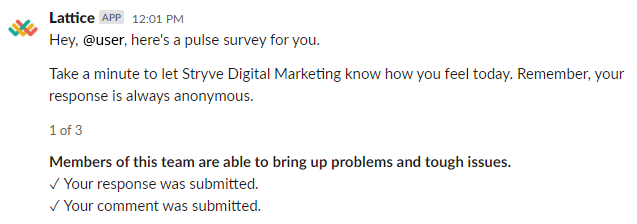How to measure psychological safety in your team
By: Sarah Rosenquist
November 24, 2021 | Reading Time: 5 mins
What do you think makes a team successful? What separates a high-performing team from an average team? In 2015, Google worked hard to answer these questions through what they called Project Aristotle. Their results showed that the most successful teams had specific traits. The number one trait was psychological safety. So what’s the deal with psychological safety? In short, it refers to a team where members feel safe to take risks and be vulnerable with each other.
When Google was picking apart psychological safety, they consulted with Amy Edmondson, a Harvard organizational behavioural scientist. She suggested asking employees how strongly they agreed or disagreed with 7 simple questions:
- If you make a mistake on this team, it is often held against you.
- Members of this team are able to bring up problems and tough issues.
- People on this team sometimes reject others for being different.
- It is safe to take a risk on this team.
- It is difficult to ask other members of this team for help.
- No one on this team would deliberately act in a way that undermines my efforts.
- Working with members of this team, my unique skills and talents are valued and utilized.
Why bother measuring psychological safety?
If you’re trying to make your team more successful, you first need a baseline to compare with. A lot of people will think they have a good feel for their team’s psychological safety. But it’s surprising what you’ll learn when you actually measure it. I know I was. Start measuring it now to help future you.
Starting to measure psychological safety will also start the conversation about it with team members. When you’re answering the questions, it makes you think about your feelings and the dynamic of the team. Even though the prompts ask you about how others make you feel, everyone at Stryve has said they couldn’t help but consider how their own actions could impact others on the team. With that, just by taking the survey, you’re already getting a head start on making improvements. Just make sure you’re explaining why psych safety is important and why you’re investing everyone’s time in it.
Each team member has their own comfort level and communication style, so everyone’s experience is personal. You can’t apply your own feelings to others. I find this message to be especially important to leaders, who are more secure in their jobs and often overestimate psychological safety in their teams.
How we started measuring psychological safety in 2016
We took the questions that Google used for their psychological safety survey and expanded it for some additional data points. We wanted to see which of these characteristics were consistent across team members and where there was a disparity. For example: are there certain people who encourage you to take risks? Are there others who wouldn’t? So we asked each question twice, priming it differently:

The results let us see the difference between the average for those we’re most comfortable with and those we’re least comfortable with. Prompts that had a higher disparity between these two answers pointed to interpersonal issues. Prompts with similar answers were more about our culture.
We also worded each prompt in a positive way, so that answering ‘strongly agree’ for each question was the desired state. An example of this would be changing the prompt “People on this team sometimes reject others for being different,” to “People on this team do not reject others for being different.” This made analysis easier and kept each respondent focused on the ideal behaviours.
We were administering this through an anonymous Google Form and analyzing the data ourselves through spreadsheets and graphs. This was manageable when our team was small. As we grew, it became more time-consuming and difficult to pull insights. Luckily, as time has gone on, psychological safety has become a more widely recognized business concept and tech solutions have popped up to support teams in establishing better work cultures.
How we upgraded our psychological safety measurement
We implemented Lattice’s People Management platform, which already had employee engagement questions related to psychological safety built into it. Better yet, Lattice allows us to check in with our team more regularly through mini pulse surveys. Instead of polling everyone twice a year, we’re getting continuous feedback from the team and avoiding recency bias. It even integrates with our Slack to make it super simple for everyone to respond.

Lattice also analyzes the data for us in real-time. This means we spend less time administering psychological safety surveys and more time actively working to improve our psychological safety. At any time, we can pop in and view our scores and compare them over time.

All the data is anonymized to help keep responses honest, and this is really important. It did make things difficult though, because we couldn’t engage in a conversation with the respondent to further understand their scores or clarify their comments. When people don’t feel psychologically safe, it’s unlikely they’ll be comfortable talking about it in a meeting. Thankfully, Lattice helped us with that, too. Now, we can have conversations about pulse surveys without losing anonymity.
Overall, we’re getting more data and analysis faster than we ever could by administering psychological safety surveys manually. It’s been a big win.
What do you do next?
Dive deep into your data. Depending on the results, there may be different ways you want to present it to the rest of the team. Either way, keep the survey and its results so that you can retest and see your progress.
If there are some trouble areas
With psychological safety, it’s really important not to single anyone out. Don’t view this as a problem that needs to be dissected and addressed. Instead, focus your team on new ways of working together. Process, environment, and people all drive feelings of psychological safety. You have to be willing to shake those things up. Have a look at what managers can do to foster psychological safety and get inspired by Google’s re:Work content on teams.
If the results are mostly positive
Highlight your strongest areas and give the team a pat on the back. But don’t get complacent! Our surveys showed that we were doing well with psychological safety, but there were areas that were weaker than others. Now we’re picking apart our culture to see what drives these feelings, and ultimately that will help us improve the responses. We’ll know if it’s working because we’ll continue measuring psychological safety and comparing the results over time.
We’ll help you get started
Before handing out psychological surveys, we recommend presenting the topic to your team so they can better understand the goal of what you’re doing. To help you get started, download our “Intro to Psychological Safety” presentation deck.









